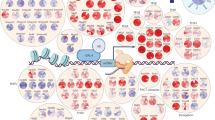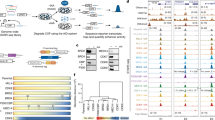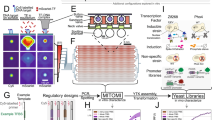Abstract
Most class B (II) promoter regions from higher eukaryotes contain the TATA box and upstream and enhancer elements1. Both the upstream and enhancer elements and their cognate factors have regulatory functions, whereas the TATA sequence interacts with the TATA box factor BTF1 to position RNA polymerase B and its ancillary initiation factors (STF, BTF2 and BTF3) to direct the initiation of transcription ∼30 base pairs downstream2. In many respects, class B promoter regions from the unicellular eukaryote Saccharomyces cerevisiae are similarly organized, containing upstream activating sequences that bear many similarities to enhancers3,4. Although they are essential for initiation, the yeast TATA sequences are located at variable distances and further from the start sites (40–120 base pairs), whose locations are primarily determined by an initiator element4. The basic molecular mechanisms that control initiation of transcription are known to be conserved from yeast to man: the yeast transcriptional trans-activator GAL4 can activate a minimal TATA box-containing promoter in human HeLa cells, and a human inducible enhancer factor, the oestrogen receptor, can activate a similar minimal promoter in yeast5–8. This striking evolutionary conservation prompted us to look for the presence in yeast of an activity that could possibly substitute for the human TATA box factor. We report here the existence of such an activity in yeast extracts.
This is a preview of subscription content, access via your institution
Access options
Subscribe to this journal
Receive 51 print issues and online access
$199.00 per year
only $3.90 per issue
Buy this article
- Purchase on SpringerLink
- Instant access to full article PDF
Prices may be subject to local taxes which are calculated during checkout
Similar content being viewed by others
References
Wasylyk, B. CRC Crit. Rev. Biochem. 23, (in the press).
Zheng, X. M., Monocollin, V., Egly, J. M. & Chambon, P. Cell 50, 361–368 (1987).
Guarente, L. A. Rev. Genet. 21, 425–452 (1987).
Struhl, K. Cell 49, 295–297 (1987).
Webster, N., Jin, S. R., Green, S., Hollis, M. & Chambon, P. Cell 52, 169–178 (1988).
Kakidani, H. & Ptashne, M. Cell 52, 161–167 (1988).
Metzger, D., White, J. & Chambon, P. Nature (in the press).
Guarente, L. Cell 52, 303–305 (1988).
Miyamoto, N. G. et al. Nucleic Acids Res. 12, 8779–8799 (1984).
Dezélée, S., Wyers, F., Sentenac, A. & Fromageot, P. Eur. J. Biochem. 65, 543–552 (1976).
Moncollin, V., Miyamoto, N. G., Zheng, X. M. & Egly, J. M. EMBO J. 5, 2577–2584 (1986).
Davison, B. L., Egly, J. M., Mulvihill, E. R. & Chambon, P. Nature 301, 680–686 (1983).
McNeil, J. B. & Smith, M. J. molec. Biol. 187, 363–378 (1986).
Fire, A., Samuels, M. & Sharp, P. A. J. biol. Chem. 259, 2509–2516 (1984).
Reinberg, D., Horikoshi, M. & Roeder, R. G. J. biol. Chem. 262, 3322–3330 (1987).
Reinberg, D. & Roeder, R. G. J. biol. Chem. 262, 3310–3321 (1987).
Huet, J., Sentenac, A. & Fromageot, P. J. biol. Chem. 257, 2613–2618 (1982).
Allison, L. A., Wong, J. K. C., Fitzpatrick, V. D., Moyle, M. & Ingles, C. J. Molec. cell. Biol. 8, 321–329 (1988).
Bartolomei, M. S., Halden, N. F., Ruta Cullen, C. & Corden, J. L. Molec. cell. Biol. 8, 330–339 (1988).
Biggs, J., Searles, L. L. & Greenleaf, A. L. Cell 42, 611–621 (1985).
Takahashi, K. et al. Nature 319, 121–126 (1986).
Sawadogo, M. & Roeder, R. G. Cell 43, 165–175 (1985).
Chodosh, L. A. et al. Cell 53, 25–35 (1988).
Wasylyk, C. & Wasylyk, B. EMBO J. 5, 553–560 (1986).
Moran, L. et al. Cell 17, 1–8 (1979).
Author information
Authors and Affiliations
Rights and permissions
About this article
Cite this article
Cavallini, B., Huet, J., Plassat, JL. et al. A yeast activity can substitute for the HeLa cell TATA box factor. Nature 334, 77–80 (1988). https://doi.org/10.1038/334077a0
Received:
Accepted:
Issue Date:
DOI: https://doi.org/10.1038/334077a0



